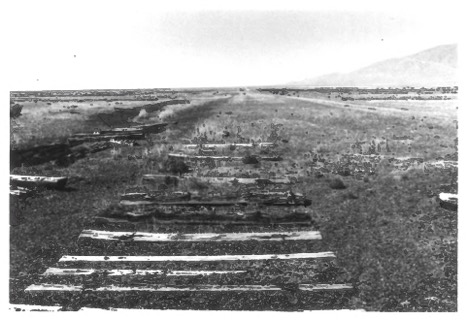Archaeology of Terrace UT II 2021 - Passport in Time
Main menu:
Current Projects > 2020 > 2021
Closed! Archaeological Investigations at Terrace, Utah: Part II

Looking west at the former switchyard in Terrace, Utah about 1980
UT-4455
May 9-15, 2021
Volunteers must commit to entire session
The construction of the first Transcontinental Railroad (TCRR) across the United States was a magnificent undertaking, years in planning and years in execution. Historian Stephen Ambrose said of the effort, “…there is nothing like it…” Reaching west from Omaha to Sacramento, across the vast grasslands of the Great Plains, the Rocky Mountains, and the high Sierras, the Transcontinental Railroad cut an impressive swath through Utah, north of the Great Salt Lake. Beginning in 1869 and continuing through the early years of the 1900s, it was the main corridor of socioeconomic growth and development in the western United States.
In an effort to improve the efficiency of the railroad in Utah, the Lucin Cutoff was constructed. When completed in 1904, it traversed the Great Salt Lake between Ogden on the east and Lakeside on the west. Use of the Cutoff effectively bypassed approximately 90 miles of the TCRR north of the Great Salt Lake, which then became known as the “Promontory Segment;” it is the longest continuous portion of the original TCRR that remains intact. The Promontory Segment was home to numerous maintenance sidings and two large town sites: Kelton and Terrace; the latter will be the focus of this PIT project.
Terrace was founded in 1869, and boasted a population of 800-1,000 inhabitants during its late 1880s/early 1890s heyday; the town served primarily a maintenance function for trains and track. The maintenance facilities at Terrace included a roundhouse, whose structural remains are still visible on the surface – as many as ten trains per day were serviced at Terrace. It was an active commercial and residential hub with thriving businesses and a relatively active artistic community centered on the Athenium. With the completion of the Lucin Cutoff and the subsequent decline in rail traffic, Terrace began to languish and by 1910 it ceased to exist as a coherent community.
Terrace exists today as a very large archaeological site, a site that is a vast repository of information pertaining to 19th-century ethnic relations, economic systems, technological innovations, and frontier urban development and collapse.
The primary goal of the 2021 Terrace PIT project is to expand upon what we learned from our first field season there in September 2020. The analysis of surface deposits revealed interesting and unexpected patterns in the material culture associated with various ethnicities present at Terrace between 1869 and ~1910. In addition, excavations in “Chinatown” provided unique insight into life at Terrace for the Chinese population in the late 19th century. We will be expanding those excavations and expect to learn much more. 2021 efforts will be geared toward acquiring additional data related to existing spatial relationships among the various entities that occupied Terrace in the late 19th century, learning more about the economics of life at Terrace, and finally, evaluating the potential for buried deposits that may shed light on these questions. The field methods employed to obtain these data and achieve these goals include surface inventory, and advanced technology like ground penetrating radar and x-ray fluorescence.
Surface inventory will entail volunteers systematically walking the site and identifying artifacts of interest, mapping their location, photographing them, and providing a brief description. All of this information will be compiled into a site map that will be used to better define activity areas, structure locations, and domestic and commercial areas. These data will provide a basis for thorough and accurate interpretations of the site as well as helping to delineate portions of the site worthy of additional testing.
Ground Penetrating Radar is a type of remote subsurface testing that is geared toward gathering data about buried deposits worthy of additional investigation. X-ray fluorescence is a technique that allows the elemental composition of certain types of artifacts to be identified. This information can be helpful in learning where these artifacts, or the raw materials used to produce them, may have originated. These data can be used to reconstruct socioeconomic patterns, thus contributing to the broader interpretation of the site. Volunteers will assist professionals trained in the use of these technologies in data collection and interpretation. There is much to learn and see during the course of this project, so we hope to see you again this spring!
Please note: Strict COVID-19 protocols will be followed, including the wearing of masks, social distancing, etcetera. Additionally, given current national and global circumstances, some aspects of the project may be subject to change. The project leader will notify all selectees should this occur.
Number of openings: 10
Special skills: No special skills required
Minimum age: 18 years old
Facilities: We will be camping on-site (at Terrace) and all volunteers will be responsible for providing their own meals, water, etc. – there are no facilities at Terrace whatsoever…the good news is that you will have a first-hand experience of what it must have been like living at Terrace when it was originally founded as a railroad construction town in 1869! Volunteers responsible for own bedding and transportation to and from initial meeting location
Nearest towns: Snowville, UT; ~70 miles; Tremonton, UT, ~100 miles
Applications due: April 5, 2021
View Archaeology of Terrace, UT II in a full screen map
